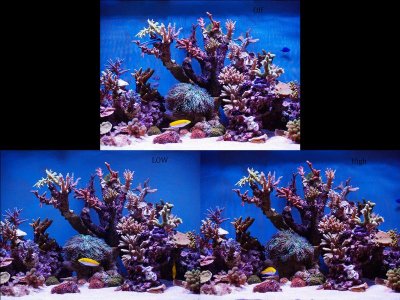Hi, Im Chris from the UK. I spend a lot of time researching on here and thought i'd post my experiment.
Seeing the results from the BRS video on Philips new light is got me thinking. I was wondering how close I could get to T5 lighting from my Hydra 52's. The idea was to take what was essentially multiple small lights sources (smaller light sources create shadow and reduces wrap) and turn them into one really big one.
The principle is based on my photography experience of lighting where softboxes are used to turn the small flashtube into a large flat light source that mimics window light. My problem with the Philips light is to my mind the diffuser is too close to the light source to have a massive effect.
I bought a 1200mm x 600mm £10 sheet of prismatic diffuser panel and have taken photos in manual exposure mode with a set white balance and shutter speed /aperture / ISO. The results shown are:
Off: No diffuser
Low : Diffuser panel sitting on the top of my mesh tank cover
High Diffuser held 2" from the lens of the hydras
Off, obviously lots of ripple and much more pronounced hot zones on the tops of corals.
High, much less ripple and hot zones seem reduced
Low, almost no ripple, some light loss and hot zones seem much less.
I have to test it long term and as I have plenty of power in reserve am going to increase intensity by 10% on all channels. I make no claims to anything other than I'm trying it, hopefully its of interest to someone and wont see me subjected to a barrage of negativity as my experiments often seem to do on other sites.
Picture shows the differences, excuse the algae not cleaned in a while. A small thing I note is that the black band off the top of the tank is from my mesh cover, its cut short to accommodate the slimline ai brackets and with the low diffuser position the shadow is massively reduced!
Seeing the results from the BRS video on Philips new light is got me thinking. I was wondering how close I could get to T5 lighting from my Hydra 52's. The idea was to take what was essentially multiple small lights sources (smaller light sources create shadow and reduces wrap) and turn them into one really big one.
The principle is based on my photography experience of lighting where softboxes are used to turn the small flashtube into a large flat light source that mimics window light. My problem with the Philips light is to my mind the diffuser is too close to the light source to have a massive effect.
I bought a 1200mm x 600mm £10 sheet of prismatic diffuser panel and have taken photos in manual exposure mode with a set white balance and shutter speed /aperture / ISO. The results shown are:
Off: No diffuser
Low : Diffuser panel sitting on the top of my mesh tank cover
High Diffuser held 2" from the lens of the hydras
Off, obviously lots of ripple and much more pronounced hot zones on the tops of corals.
High, much less ripple and hot zones seem reduced
Low, almost no ripple, some light loss and hot zones seem much less.
I have to test it long term and as I have plenty of power in reserve am going to increase intensity by 10% on all channels. I make no claims to anything other than I'm trying it, hopefully its of interest to someone and wont see me subjected to a barrage of negativity as my experiments often seem to do on other sites.
Picture shows the differences, excuse the algae not cleaned in a while. A small thing I note is that the black band off the top of the tank is from my mesh cover, its cut short to accommodate the slimline ai brackets and with the low diffuser position the shadow is massively reduced!



